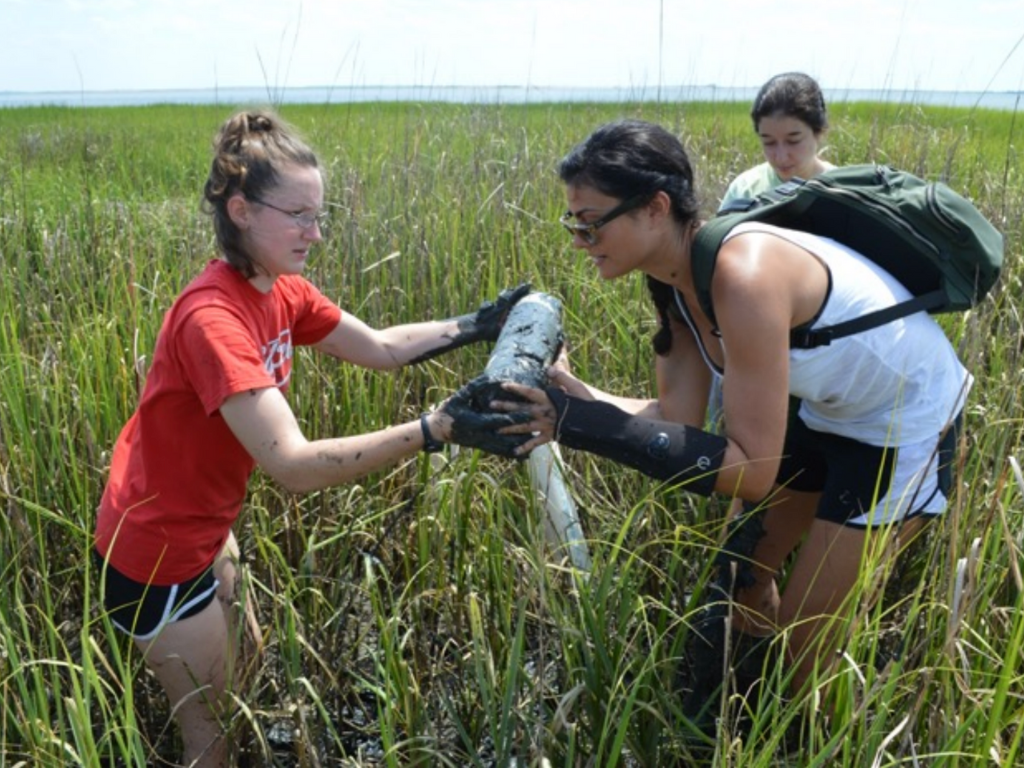 Understanding our world
Understanding our world
In the School of Earth and Atmospheric Sciences (EAS), students and faculty alike are motivated by the desire to understand the world around us. Dramatic events often trigger our curiosity — events such as the destruction brought on by a tornado, the trembling of an earthquake, health concerns due to air pollution, the beauty of mountain ranges, and the many other ways our planet affects our everyday lives. The EAS curriculum emphasizes the application of basic scientific principles to understand the earth, oceans, atmosphere, and planetary science. High quality undergraduate teaching is important in EAS and relatively small class sizes provide ample opportunities for close interaction with EAS faculty
Download fact and major information as a pdf here.
Research, laboratory, and field work experience
EAS further supplements classroom training with hands on experiences in laboratories and the field. There are also exciting opportunities to do research with faculty, including the Summer Undergraduate Research Experience, which includes a weekly series of seminars and panel discussions. During their undergraduate career in EAS, students may monitor ozone levels in urban Atlanta, analyze river water quality, use programming and visualization software to track motion in the oceans or atmosphere, model glacial stream changes, or examine satellite data.
 Expanding horizons
Expanding horizons
EAS majors can become environmental scientists, air quality specialists, earth scientists, and meteorologists (EAS majors focusing on meteorology can meet all the requirements of the American Meteorological Society and/or the National Weather Service). EAS alumni are employed by The Weather Channel, CNN, 11 Alive, environmental consulting firms, IBM, the Atlanta Regional Commission and state environmental agencies, the Environmental Protection Agency, and NASA. Many other students have gone on to pursue graduate degrees.
Undergraduate internships
Undergraduate EAS students have participated in a variety of paid and for credit internships, expanding their repertoire of knowledge. For example:
NASA Smithsonian Institution • CNN • FOX Environmental • National Weather Service • UNACVO
Undergraduate research
Undergraduate students working in world renowned research groups in the school have contributed to research that has been presented at national and international conferences and published in leading scholarly journals.
For example:
- Samantha Motz presented at the 2022 Geological Society of America Conference on her zircon work with Dr. Karl Lang about how the lower Colorado River might have changed over million-year timescales.
- Based on their research, Logan Mann was the first author on the paper “Synchronization of Heinrich and Dansgaard-Oeschger Events Through IceOcean Interactions,” published in Paleoceanography and Paleoclimatology.
- Undergraduate students Autumn Toms and Isaac Sipp-Allpers helped to identify and pick out tiny shells of single celled organisms called foraminifera and analyzed their carbon isotopic composition in order to reconstruct past oxygen under Dr. Lynch-Stieglitz and graduate student Tyler Vollmer, resulting in an American Geophysical Union Conference presentation.
- Nadiyah Williams collaborated with Georgia Tech Research Institute (GTRI) researchers, John Trostel and Jessica Losego, comparing X-band radar rainfall estimates in the Atlanta-Athens area.
 Careers
Careers
EAS Graduates take positions in all types of employment sectors, such as:
- Meteorology • Geochemistry • Seismology • Geophysics Environmental Monitoring • Climatology • Land Use Planning • Oceanography • State and Federal Agencies (e.g., NOAA, NASA, • Consulting USGS, EPA)
- The B.S. program in Earth and Atmospheric Sciences also provides exceptional levels of preparation for admission to graduate study and professional graduate programs.
- Georgia Tech ranks first in the nation in terms of the annual percentage return on investment whereby lifetime salary is compared to tuition costs [1].
- The U.S. Department of Labor reports an average range of salaries for Earth and Atmospheric Scientists (geoscientist, atmospheric and space scientists, and hydrologists) of $79,000‐93,000
Contact information
For more information, please see eas.gatech.edu, or contact the school’s undergraduate advisors, Zachary Handlos (zachary.handlos@eas.gatech.edu) or Samantha Wilson (samantha.wilson@eas.gatech.edu).
[1] www.payscale.com [2]www.bls.gov/oes/current/oes192042.htm [3]www.bls.gov/oes/current/oes192021.htm [4]www.bls.gov/oes/current/oes192043.htm


